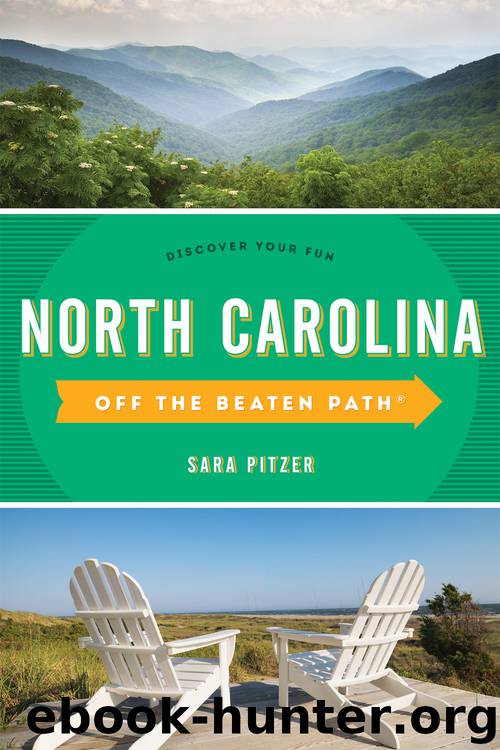North Carolina Off the Beaten Path® by Sara Pitzer

Author:Sara Pitzer
Language: eng
Format: epub
ISBN: 9781493027583
Publisher: Globe Pequot Press
Published: 2017-04-17T16:00:00+00:00
Heartland
Another possible trip from Asheboro is the short hop up US 220 to Greensboro, a pleasant city with a historic downtown and lots of surprises. There’s some Revolutionary War history here, in a strange sort of way. Cornwallis won a battle against General Nathanael Greene’s American troops, but in the process he lost so many men that he ultimately had to surrender at Yorktown. The Guilford Courthouse National Military Park, 6 miles north of Greensboro on US 220, commemorates the loss and the win with exhibits on the battlefield and displays and films in the visitor center (336-288-1776; nps.gov/guco). Hours vary seasonally. Admission is free.
Drawing on more recent events, Greensboro holds special significance for blacks. In 1960 black students from North Carolina A & T State University (originally the Agricultural and Mechanical College for the Colored Race) began the first sit-ins at Woolworth’s segregated lunch counter. A & T is Jesse Jackson’s alma mater. On the campus of North Carolina A & T State University, the Mattye Reed African Heritage Center displays African masks, paintings, black history books, and art objects. Open Mon through Fri 10 a.m. to 5 p.m. Closed on University holidays (336-334-7108; www.ncat.edu/cahss/departments/vpa/visual-arts/university%20galleries.html). Admission is free.
Less than 10 miles east of Greensboro, the Charlotte Hawkins Brown Memorial State Historic Site (336-449-4846; ah.dcr.state.nc.us) honors Dr. Brown’s 50 years as head of another school for blacks, Palmer Memorial Institute. The buildings are gradually being restored, and plans are to make the memorial a center for contributions of North Carolina blacks, including a research center with collection and computer facilities devoted to North Carolina black history. The complex includes cottages and dormitories, outdoor exhibits and trails, a visitor center in the old teacher’s cottage, and a picnic area. Dr. Brown’s house has been restored, and some of her original furniture reupholstered. Open Tues through Sat from 9 a.m. to 5 p.m. Closed for major holidays. Admission is free.
Local history from the time of the early Indians to date shapes the displays at the Greensboro Historical Museum (130 Summit Ave., Greensboro; 336-373-2043; greensborohistory.org) in what used to be the First Presbyterian Church. In a re-creation of 19th-century Greensboro, the museum displays a general store, the drugstore where William Sydney Porter (O. Henry) once worked, a post office, a law office, a firehouse, a cobbler’s, and a blacksmith’s.
Other exhibits include room settings from historical homes, an exhibit of household items and clothing of Dolley Madison (a Greensboro native before she became First Lady), and a collection of antique automobiles. Open Tues through Sat from 10 a.m. to 5 p.m. and Sun from 2 to 5 p.m. Closed holidays. Admission is free.
If you’re traveling with kids (or even if you’re not, come to think of it), don’t miss the Natural Science Center (4301 Lawndale Dr.; 336-288-3769; natsci.org), where you can easily spend a day immersing yourself in the sights and sounds of everything from dinosaurs to star systems. This is a “participation museum,” where you don’t have to tell the kids “look, don’t touch.
Download
This site does not store any files on its server. We only index and link to content provided by other sites. Please contact the content providers to delete copyright contents if any and email us, we'll remove relevant links or contents immediately.
Giovanni's Room by James Baldwin(7197)
The Plant Paradox by Dr. Steven R. Gundry M.D(2548)
The Stranger in the Woods by Michael Finkel(2454)
Miami by Joan Didion(2324)
Wild: From Lost to Found on the Pacific Crest Trail by Cheryl Strayed(2214)
INTO THE WILD by Jon Krakauer(2157)
DK Eyewitness Top 10 Travel Guides Orlando by DK(2131)
Trail Magic by Trevelyan Quest Edwards & Hazel Edwards(2127)
Vacationland by John Hodgman(2090)
The Twilight Saga Collection by Stephenie Meyer(2087)
Nomadland by Jessica Bruder(2015)
Birds of the Pacific Northwest by Shewey John; Blount Tim;(1925)
The Last Flight by Julie Clark(1911)
Portland: Including the Coast, Mounts Hood and St. Helens, and the Santiam River by Paul Gerald(1885)
On Trails by Robert Moor(1853)
Deep South by Paul Theroux(1786)
Blue Highways by William Least Heat-Moon(1722)
Trees and Shrubs of the Pacific Northwest by Mark Turner(1682)
1,000 Places to See in the United States and Canada Before You Die (1,000 Places to See in the United States & Canada Before You) by Patricia Schultz(1609)
